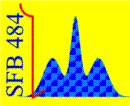
Second International Workshop 2004
Ordering Phenomena in Transition Metal Oxides
September 26 - 29, 2004, Wildbad Kreuth
|
Welcome Pictures taken at the Workshop Invited Speakers Program Poster Session Social Program Organization Technical Information Travel Information Weather SFB 484 Institute of Physics |
|
Invited Talk
|
|
| H. von Löhneysen (Karlsruhe) | |
|
New phases of transition metal compounds
|
|
|
Recent advances in the characterization of new magnetic phases in
transition metal compounds with focus on Mn-Si alloys and compounds
will be reviewed. (1) Mn5Si3 is a well-known
antiferromagnet (TN = 90 K) which by doping with
interstitial C can be turned into a ferromagnet with a maximum Curie
temperature Tc = 152 K for
Mn5Si3Cx with x = 0.22
[1]. We recently succeeded in driving Tc to 350 K
by magnetron sputtering at elevated substrate temperatures [2]. This
is accomplished by an enhanced non-equilibrium C concentration
x = 0.75 where the average moment per Mn atom amounts to
≈ 0.9 μB. X-ray absorption spectroscopy does
not show a significant valence change of the inequivalent-site
MnI or MnII atoms, ruling out a
double-exchange mechanism as origin of the stabilization of magnetic
order. For Mn5Ge3Cx, even a maximum
of Tc = 445 K has been reached. (2)
Mn3Si has long been known as an incommensurate
antiferromagnet (TN = 25 K) with a sequence of
alternating MnI and MnII ferromagnetic planes,
separated by a Si plane, and ordered moments &muI = 1.7
&muB and &muII = 0.19 &muB oriented
in plane [3]. Here a surprising stability of the magnetically
ordered state in magnetic ordered fields up to 14 T was found, as
evidenced by the invariance of specific heat, magnetization, and
electrical resistivity measured on polycrystalline Mn3Si
samples [4]. This invariance under magnetic field is in marked
contrast to the rather low TN and suggests the
presence of a yet unknown high-energy scale which might be related
to the most unusual magnetic fluctuation spectrum in this compound
[3]. (3) MnSi is a particularly clean system where the magnetic
ordering temperature can be tuned to T = 0 by hydrostatic
pressure. The long-wavelength spiral structure (wavelength 180
Å) retains its periodicity when approaching the critical
pressure where Tc → 0 but loses its
orientation, as observed via neutron scattering under pressure
[5]. This “partial melting’’ is reminiscent of
orientational order in liquid crystals and presents a truly novel
magnetic phase. How this partial order is related to the
non-Fermi-liquid behavior observed in electronic transport over an
extended pressure and field range [6] has yet to be established.
[1] J. P. Senateur et al., Bull. Soc. Fr. Min. Crist. 90, 537 (1967) [2] C. Sürgers et al., Phys. Rev. B 68, 174423 (2003) and refs. therein [3] S. Tomiyoshi et al., J. Phys. Soc. Jpn. 39, 295 (1975); Phys. Rev. B 36, 2181 (1987) [4] C. Pfleiderer et al., Phys. Rev. B 65, 172404 (2002) [5] C. Pfleiderer et al., Nature 427, 227 (2004) [6] C. Pfleiderer et al., Nature 414, 427 (2001) |
|
|
previous / next - Invited Speakers - Program |
|
| [ 21-Apr-17 ] | [ http://www.physik.uni-augsburg.de/sfb484/Kreuth2004/abstracts/loehneysen.shtml ] |